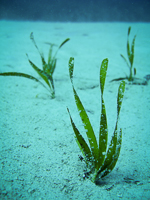ABSTRACT
We studied the role of hydrodynamics in the establishment of seagrass seedlings for two Mediterranean sea grass species, Posidonia oceanica and Cymodocea nodosa, by combining flume and field studies. Flume measurements under both unidirectional and oscillatory flow showed that P. oceanica seedlings experienced higher drag forces than C. nodosa, which could be related to the larger total leaf area.
Drag coefficients were between 0.01 and 0.1 for Reynolds numbers of 103 and 105. As a result, P. oceanica seedlings required 40-50% of root length anchored to the sediment before being dislodged, whereas C. nodosa required ≈ 20%. To validate the flume results, seedling survival in sandy beds was evaluated for two depths (12 and 18 m) at two field locations. To calculate near-bottom orbital velocities at the planting sites, deep-water waves were propagated to shallow water using a numerical model.
Our results showed that P. oceanica seedlings experienced high losses after the first autumn storms when near-bottom orbital velocities exceeded 18 cm s-1. The loss of C. nodosa seedlings was much lower and some seedlings survived velocities as high as 39 cm s-1. Thus, flume and field results are consistent in explaining relative higher losses of P. oceanica seedlings than for C. nodosa.













